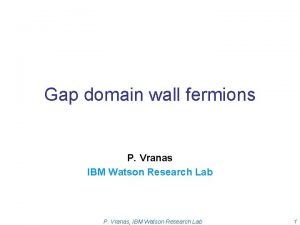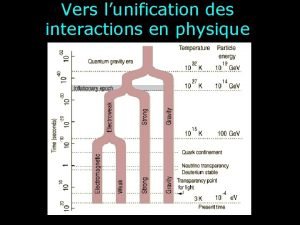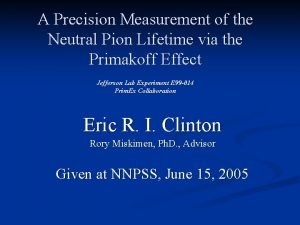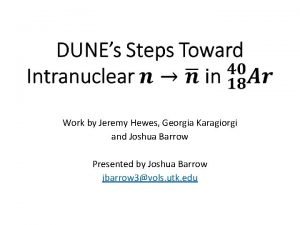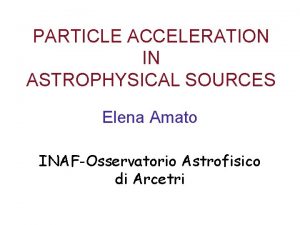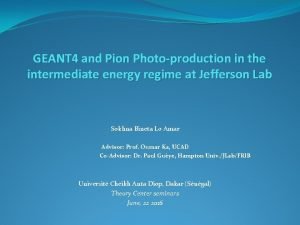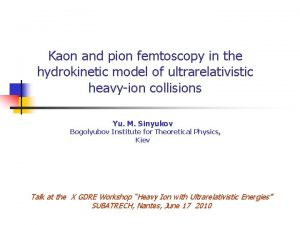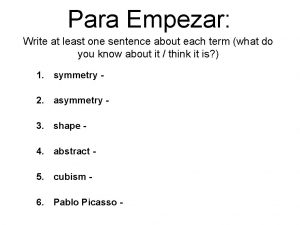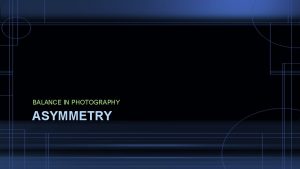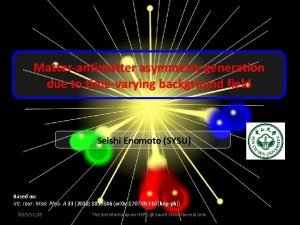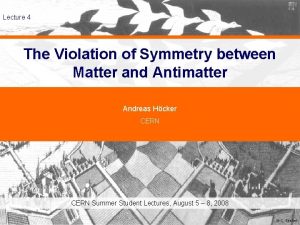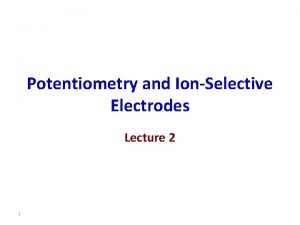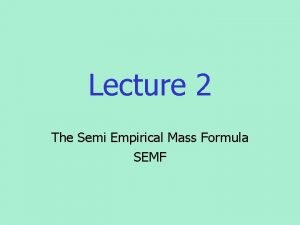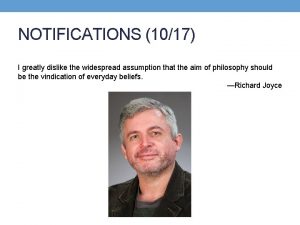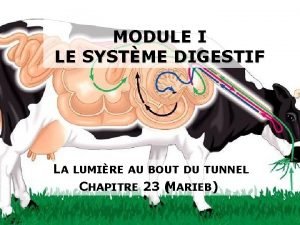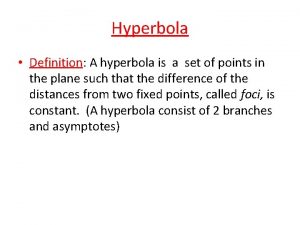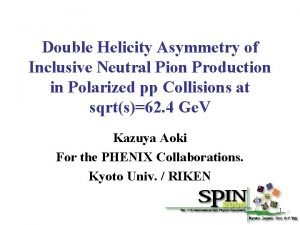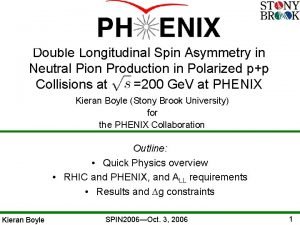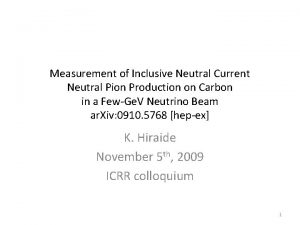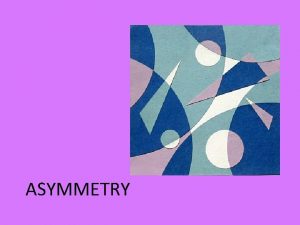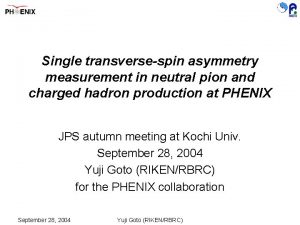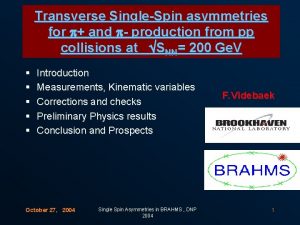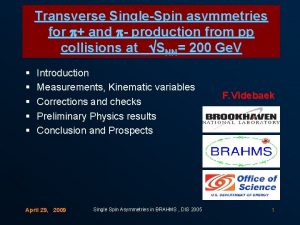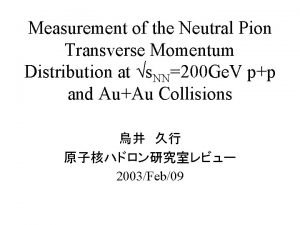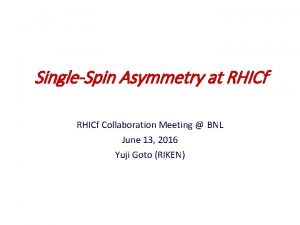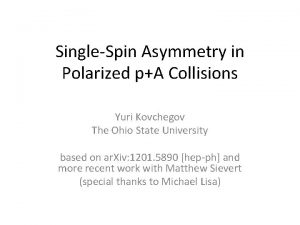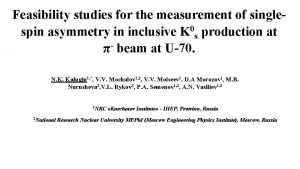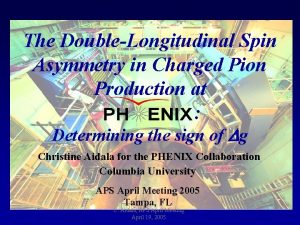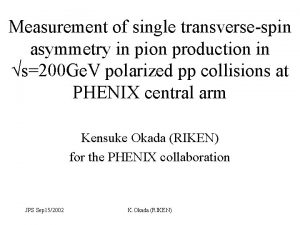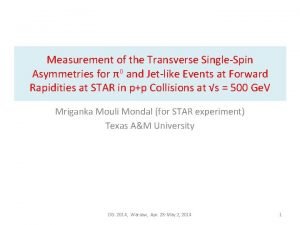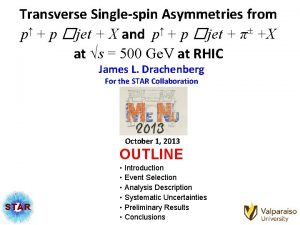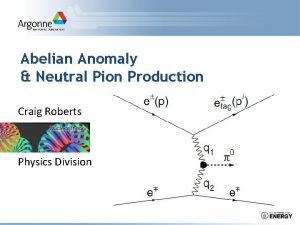SingleSpin Transverse Asymmetry in Neutral Pion Production at



















- Slides: 19

Single-Spin Transverse Asymmetry in Neutral Pion Production at Christine Aidala for the Collaboration Columbia University APS April Meeting 2004, Denver, CO C. Aidala, APS April 2004, Denver, CO

Polarized Proton Collisions at RHIC “Blue” and “yellow” rings Run-2 configuration installed for Run-3 RHIC p. C Polarimeters BRAHMS & PP 2 PP PHOBOS PHENIX STAR Siberian Snakes Spin Rotators Partial Siberian Snake LINAC BOOSTER Pol. Proton Source 500 m. A, 300 ms AGS 200 Me. V Polarimeter AGS Internal Polarimeter Rf Dipoles C. Aidala, APS April 2004, Denver, CO 2

2001 -2002 pp Run at RHIC • Transversely polarized p+p Spin direction for blue beam collisions at = 200 Ge. V flipped every ~200 ns; -1 • 150 nb written to tape for yellow beam every ~400 ns. • Average polarization of ~15% • Single-spin asymmetries calculated for each beam separately, averaging over the spin states of the other Different spin combinations for different crossings aid in canceling systematic uncertainties. C. Aidala, APS April 2004, Denver, CO 3

EMCal Pb. Sc PHENIX Detector • Central arm spectrometers – In the central arms, a finegrained EMCal equipped with photon triggers enhances p 0 measurement EMCal Pb. Gl • Muon arm spectrometers • Forward and backward luminosity detectors: – BBC (Beam-Beam Counters) – ZDC (Zero Degree Calorimeters) C. Aidala, APS April 2004, Denver, CO 4

EMCal-RICH 2 x 2 Trigger • 2 x 2 towers nonoverlapping sum • Threshold ~ 0. 8 Ge. V • Also used in conjunction with RICH to form an electron trigger 2 x 2 Trigger in 2001 -2002 run. C. Aidala, APS April 2004, Denver, CO 5

Leading Hadrons as Jet Tags fi(x 1) Hard Scattering Process fj(x 2) qg+gq qq gg In current measurement, p 0’s mainly produced by gg and qg scattering C. Aidala, APS April 2004, Denver, CO p. T (Ge. V/c) 6

Cross Section from 2001 -2 Run 0 Phys. Rev. Lett. 91, 241803 (2003) • NLO p. QCD consistent with data within theoretical uncertainties. • PDF: CTEQ 5 M • Fragmentation functions: • Kniehl-Kramer-Potter (KKP) • Kretzer p) • Spectrum constrains D(gluon fragmentation function • Important confirmation of theoretical foundation for spin program • Data from 2003 run reproduce 2001 -2 results and extend the p. T range • Will be released soon 9. 6% normalization error not shown C. Aidala, APS April 2004, Denver, CO 7

Why Measure AN at PHENIX? 0 left right • Significant asymmetries observed at fixed target energies (E 704 at FNAL, = 20 Ge. V) • Significant asymmetries observed at STAR forward p 0’s produced at = 200 Ge. V, xquark ~ 0. 6 (talk by D. Thein) • Mechanism for producing these asymmetries still not understood theoretically – “transversity” x “Collins effect”: [degree to which quarks in transversely polarized proton are transversely pol. ] x [spin-dependent fragmentation] – “Sivers effect”: spin-dependent initial partonic transverse momentum • PHENIX p 0 AN measurement explores a different kinematic region: midrapidity, xquark ~ 0. 1 • NLO p. QCD calculation of the p 0 cross section at = 200 Ge. V suggests that measuring p 0 AN at PHENIX will help to separate contributions from the Collins and Sivers effects to single transverse spin asymmetries in polarized hadron collisions C. Aidala, APS April 2004, Denver, CO Xquark = p. T/z. Ebeam 8

Calculating 0 A N Invariant mass (Ge. V/c 2) • Look for left-right asymmetry with respect to beam spin and direction Racc = relative acceptance of left and right detectors • OR look either on left or right side and compare p 0 production for + and spin states Rlumi = relative luminosity of + and - spin states Two methods provide important check of systematic errors • Then measure and subtract asymmetry of background in two different mass regions. C. Aidala, APS April 2004, Denver, CO 9

Systematic Errors In addition to calculating the asymmetry using more than one method, potential systematic errors have been investigated in the following ways: • Measured asymmetry of background – Immediately outside the p 0 mass peak – In the mass region between the p 0 and the h • • • Compared independent measurements for two polarized beams Compared results for left and right sides of detector Compared minimum bias and triggered data samples Examined fill-by-fill consistency of asymmetry values Used the “bunch shuffling” technique to check for systematic errors – Randomly reassign the spin direction to each bunch in the beam – Recalculate the asymmetry – Repeat many times (1000) to produce a “shuffled” asymmetry distribution centered around zero – Compare width of shuffled distribution to statistical error on physics asymmetry C. Aidala, APS April 2004, Denver, CO 10

AN of Neutral Pions and Non-Identified Charged Hadrons: Results Neutral pions Polarization scaling error ~30% not included PHENIX Preliminary p 0 Charged hadrons h- h+ PHENIX Preliminary C. Aidala, APS April 2004, Denver, CO 11

AN of Neutral Pions and Non-Identified Charged Hadrons: Results AN for both charged hadrons and neutral pions consistent with zero at midrapidity. C. Aidala, APS April 2004, Denver, CO 12

Conclusions qg+gq qq • The single-spin transverse asymmetry AN has been measured at midrapidity for neutral pions and charged hadrons and is consistent with zero. gg p. T (Ge. V/c) • Most of the p 0 production in the kinematic region currently measured by PHENIX is from gluon scattering, which cannot contribute to transversity x Collins, so this asymmetry measurement mainly probes the Sivers effect. The RHIC spin program looks forward to many more years of polarized proton results in the new energy regime opened up by a polarized collider. C. Aidala, APS April 2004, Denver, CO 13

Extra Slides C. Aidala, APS April 2004, Denver, CO 14

2001 -2002 p+p run • Luminosity – integrated luminosity 0. 15 pb-1 – L = 1. 5× 1030 cm-1 sec-1 at max • Polarization – transverse – <Pyellow>=17 %, <Pblue>=14 % • Cross section measurement – p 0, J/ , … • AN measurement (analysis ongoing …) – central arm (mid-rapidity, x. F ~ 0) • p 0, charged hadrons, J/ , … • Systematic studies – relative luminosity study – local polarimeter development at IP 12 C. Aidala, APS April 2004, Denver, CO 15

Polarization Measurements Physics Asymmetry (1/13/02) FILL ID: 2212 Injection 100 Ge. V • X asymmetry (physics) and Y asymmetry (false) are plotted as a function of the beam lifetime • Measurements are carried out at injection, right after ramp-up, two hours each at 100 Ge. V • Polarization remained stable over fills of many hours C. Aidala, APS April 2004, Denver, CO 16

Charged Hadron Cross Section from 2001 -2 Run PHENIX Preliminary C. Aidala, APS April 2004, Denver, CO 17

Single-Spin 0 Asymmetry at STAR For < > = 3. 7 possible contributions to AN are: Sivers Effect – Spin dependent initial partonic transverse momentum Collins Effect – Spin dependent transverse momentum kick in fragmentation Sterman and Qiu – Initial State twist 3 Koike – Final State twist 3 hep-ex/0310058 C. Aidala, APS April 2004, Denver, CO 18

E 704 Results FNAL E 704 s=23. 5 Ge. V PT=0. 5~2 Ge. V/c C. Aidala, APS April 2004, Denver, CO 19
 Peritoneal cover
Peritoneal cover Produksi multimedia adalah
Produksi multimedia adalah Pion diamonds
Pion diamonds Louis pion montre
Louis pion montre Pion lifetime
Pion lifetime Georgia karagiorgi
Georgia karagiorgi Inverse compton
Inverse compton Pion geant
Pion geant Pion
Pion Symmetrical and asymmetrical
Symmetrical and asymmetrical Asymmetry photography
Asymmetry photography Matter antimatter asymmetry
Matter antimatter asymmetry In the name of god the beneficent the merciful
In the name of god the beneficent the merciful Matter antimatter asymmetry
Matter antimatter asymmetry Asymmetry potential
Asymmetry potential Derive semi empirical mass formula
Derive semi empirical mass formula Benatar asymmetry
Benatar asymmetry Gros intestin
Gros intestin Hyperbola conjugate axis
Hyperbola conjugate axis Muscle infra hyoïdien
Muscle infra hyoïdien


